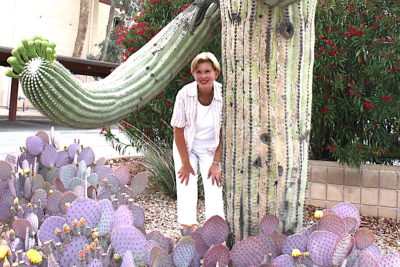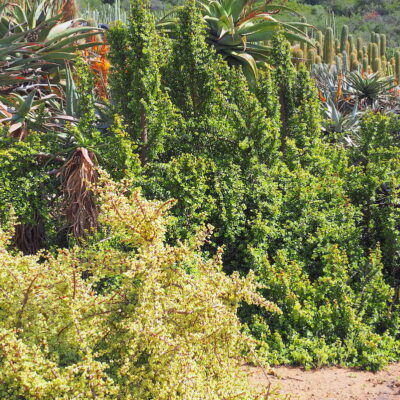Just how juicy ARE succulents? In my new video of the same name, I rank common succulents 1-to-10 on a "Juiciness Scale." Slicing and squishing may seem silly---even cruel---but there's method to my madness. I aim to entertain you, certainly, but also encourage you to learn the "how" and "why" of these marvelous plants. On this page you'll discover the fascinating Science of Succulence: how leaves, skin, roots and more make succulents, well, succulent---as well as astonishingly efficient.
The Science of Succulence
Succulents come from climates with low rainfall, strong sun and low humidity. In regions where thin-leaved plants would quickly shrivel, succulents survive---even thrive. The key is the quality of succulence: juicy, moisture-filled leaves that the plants draw on during hot, dry spells. Depending on the time of year and the variety, a succulent's moisture content may be as high as 95%.
Smart leaves

Glottiphyllum linguiforme (from the video)
Succulent leaf cells expand during rainy weather and shrink during drought. Certain varieties such as aloes also contain a gelatinous goo (mucilage). Although thick leaves mean less light reaches the plant for photosynthesis (chlorophyll + sunlight = energy for growth), that's OK because succulents are from climates with few cloudy days. In fact, some succulents further shade themselves with spines or filaments, or have a powdery coating that deflects UV light.
Waxy skin
The thick, waxy skin of succulents has comparatively few surface openings (stomata) that enable gas exchange (transpiration) with surrounding air. This minimizes evaporation and ties in with crassulacean acid metabolism (CAM), which makes succulents---in particular elephant's food (Portulacaria afra)---renowned for their ability to scrub harmful carbon from the atmosphere. Learn more.
The role of roots
Generally a tap root anchors a succulent, and it sends delicate roots laterally just below the soil surface. These shallow roots absorb even small amounts of rain and irrigation. Roots of succulents may contract during dry spells to avoid desiccation, then regrow when rains return.
Regional adaptations
Succulents are nothing if not smart! The way they deal with hostile environments is amazing. Here are two examples.

Yours Truly with a saguaro cactus in Tucson
Ribbed cacti of the desert Southwest expand during seasonal rains, then gradually shrink during periods of intense sun, high heat and low humidity. Such moisture depletion deepens surface "valleys," serving to shade the plant and lessen its exposure to the elements.

Lithops have patches of translucent tissue
In arid regions of Africa, certain small succulents have translucent tissue at their leaf tips. These dots, fissures or windows let sunlight enter plump plants that are buried up to their necks to avoid being eaten or sun-scorched. “Living stones” such as lithops as well as certain haworthias come to mind, but my favorite is Fenestraria (baby toes)---partly because the Latin name means “windows.”

Fenestraria aurantiaca (baby toes) has windowed tips

Am I crazy or cruel? Don't miss my "Juicy Succulents" video!
Related info on this site
How Succulents Combat Global Warming
When you grow succulents in your garden, you’re helping combat global warming. The plants are especially efficient at scrubbing carbon dioxide from the atmosphere. It has to do with
The post Just How Juicy ARE Succulents? The Science of Succulence appeared first on Debra Lee Baldwin. Copyright © Debra Lee Baldwin.
from Debra Lee Baldwin https://ift.tt/2OJr0qy
via IFTTT


No hay comentarios:
Publicar un comentario